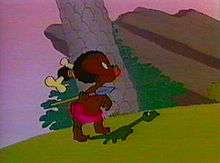Inki
| Inki | |
|---|---|
 Inki hunting in Caveman Inki | |
| First appearance | The Little Lion Hunter (1939) |
| Created by | Chuck Jones |
| Information | |
| Species | Human |
Inki is the lead character in an animated cartoon series of Warner Bros. Looney Tunes and Merrie Melodies short films by animator Chuck Jones.
History and description
Inki, created for Warner Bros.' Merrie Melodies series of theatrical animated shorts, is a little blackface African boy who usually dresses in a simple loincloth, armband, legband, earrings, and a bone through his hair. He never speaks. The character's pickaninny look was designed by Disney veteran Charlie Thorson. The plot of the cartoon focuses on little Inki hunting, oblivious to the fact that he himself is being hunted by a hungry lion.
Also central to the series is a minimalist and expressionless mynah bird, spelled "minah bird" in the title of the third short. The bird, who is accompanied by Felix Mendelssohn's The Hebrides Overture, a.k.a. "Fingal's Cave",[1] utterly disregards any obstacles or dangers. The mynah bird, shown as nearly almighty, appears randomly in the films, always intervening against the other characters. Occasionally, the bird's intervention benefits Inki by stopping Inki's pursuers. Inki then tries to thank the bird, but the latter ends up being disrespectful to Inki, too. He does not talk at all, and is droopy eyed almost all the time.
Comics historian Don Markstein wrote that the character's racial stereotype "led to [the series'] unpopularity with program directors and thence to its present-day obscurity." He noted that, "The Minah Bird, which appears immensely powerful, [is] an accomplished trickster; and yet acts, when it acts at all, from motives which simply can not be fathomed...."[1] The series' director, Chuck Jones, said these cartoons were baffling to everyone, including himself. He had no understanding of what the bird was supposed to do other than walk around. But the shorts were well-accepted by audiences.[2] According to Terry Lindvall and Ben Fraser, Inki is an Everyman who encounters mysterious forces of life. He serves as a symbol of all humanity, "frustrated and rescued by the wonderfully inexplicable".
Appearances
- The Little Lion Hunter (October 7, 1939)[1]
- Inki and the Lion (1941)
- Inki and the Minah Bird (1943)
- Inki at the Circus (1947)
- Caveman Inki (November 25, 1950)[1]
Cameos
The mynah bird has had cameos in later Warner Bros. cartoons:
In 1990, the Tiny Toon Adventures episode titled "Buster and the Wolverine" featured a cameo by the mynah bird, who interrupts the wolverine as it had cornered Buster and friends.
The 1994 episode "Bad Mood Bobby" of the Animaniacs segment "Goodfeathers" features a cameo by the mynah bird. Bobby is having a bad day and sees the mynah bird caged in a pet shop. Squit and Pesto think they can cheer Bobby up by laughing at the mynah bird's ugliness. The Fingal's Cave Overture begins playing, the mynah bird lets himself out of his cage, kicks Bobby into a streetlight, then returns to his cage.
Also, in 1999, The Sylvester and Tweety Mysteries episode "A Mynah Problem", Sylvester is seen trying to catch the mynah bird. The bird also appeared in an earlier episode, "It Happened One Night Before Christmas".
In the direct-to-video film Tweety's High-Flying Adventure (2000), the mynah bird saved Tweety from the attacks of Pete Puma and Leo Lion by wrestling them, enabling Tweety to gather the big cats' paw prints.
Home media
The 1986 videotape "I Taw a Putty Tat" included The Little Lion Hunter, Inki and the Lion, and Inki at the Circus. Also, in 2004, the "Cartoon Craze" DVD included Inki and the Minah Bird.
Sources
- Cohen, Karl F. (2004), "Racism and Resistance:Stereotypes in Animation", Forbidden Animation: Censored Cartoons and Blacklisted Animators in America, McFarland & Company, ISBN 978-0786420322
- Lindvall, Terry; Fraser, Ben (1998), "Darker Shades of Animation:African-American Images in the Warner Bros. Cartoon", in Sandler, Kevin S., Reading the Rabbit: Explorations in Warner Bros. Animation, Rutgers University Press, ISBN 978-0813525389
References
- 1 2 3 4 Inki and the Minah Bird at Don Markstein's Toonopedia. Archived from the original on August 22, 2015.
- ↑ Lindvall, Fraser (1998), p. 126-127